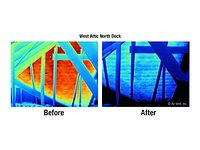Julien Benjamin Jr. was the first to hire me into the roofing industry and was a mentor of mine far beyond the time we spent working together. He was darn good at what he did and he always ran a first-rate shop. One of the first lessons he taught me comes to mind at this point in the world of commercial roofing: "Never be ashamed to make a profit."
The commercial roof-contracting industry finds itself in the midst of a tremendous opportunity to advance in stature and profitability. With a combination of escalating energy costs, continuing concern over air quality, and the increasing debate over global warming, the entire building envelope is being viewed as part of the solution to the problems. And roofing systems have emerged as the darling of the new wave of code and design changes.
The opportunity is clear, and our building-owner clients are looking for ways to cash in on energy savings as well as tax breaks in some situations. They seem willing to take some time to evaluate the value of a highly reflective, better-insulated roofing system. Some are willing to look at the garden roof solution as a way to save money, put forward an environmentally friendly building and even conserve land otherwise needed for storm water management.
While the opportunity is clear, the solutions are not completely clear. Designing roofing systems for new and retrofit applications takes on new dimensions at a time when codes are in the midst of change, as seen in California's Title 24 and the Chicago Energy Code. Many owners want to see solutions that will pay dividends in reduced energy consumption, including solutions that may far exceed existing code requirements. They want a clear definition of return on investment if they are going to invest in superior building-envelope components.
While the task of building design goes to others, roofing contractors maintain a vital role in the design process. Roofing contractors are frequently required to come up with roofing system criteria in retrofit situations and are often called upon by owners, designers and consultants to solve roofing problems. However, playing a role in the new world of the commercial roof as an integral part of an "energy-efficient building envelope system" is going to require even seasoned veterans to go back to school.
Enter SpecRight
The National Roofing Contractors Association (NRCA) is leading a coalition of other industry groups and leading roofing manufacturers to develop a consistent message about proper system design and train roofing contractors to deliver the message to building owners. The campaign is called SpecRight.Roofing Contractor learned details of SpecRight at the recent International Roofing Expo. If you missed that opportunity, you can learn more about it on page 6 of this month's issue. I highly recommend that you take the time to learn how you can leverage this good work to benefit your clients as well as your roofing business. There are many issues relating to building more sustainable, energy-efficient roofs, and the idea of coming up with a clear, concise message is right on time.
SpecRight will be a long-term and significant body of work for the commercial roofing industry. Substantial change in the area of building-envelope design is already under way. Roofing contractors need to step up and take ownership of their piece of this work. Those who move in early stand to gain the reputation as the "go-to" contractor and will be the best position to leverage changes in the marketplace into more profits. And that is nothing to be ashamed of.




